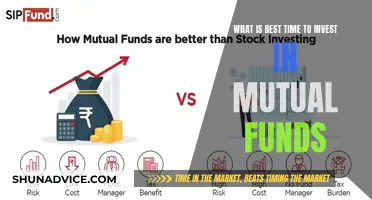
A closed-end fund is a type of investment company that raises capital by issuing a fixed number of shares through an initial public offering (IPO). Unlike open-end funds, closed-end funds do not continuously accept new investment capital and do not issue new shares or buy back shares on demand. Instead, shares in closed-end funds are traded on the open market, like stocks, and their price is determined by market demand. This means that closed-end funds can trade at a premium or discount to their net asset value (NAV). While closed-end funds can offer higher returns than open-end funds, they are also subject to more volatility due to the use of leverage.
| Characteristics | Values |
|---|---|
| Type of investment company | Closed-end fund |
| Initial public offering | Fixed number of shares |
| Investment of money raised | Stocks, bonds, money market instruments, other securities |
| Trading | Shares are traded on the open market |
| Buying and selling | Investors can buy and sell existing shares in secondary markets |
| Redemption of shares | Shares are not redeemable |
| Illiquid securities | Allowed to hold a greater percentage |
| Registration | Registered with the SEC |
| Management | Managed by investment firms |
| Distributions | Monthly or quarterly |
| Types | Traditional, interval, tender offer, business development companies |
| Leverage | Allowed, with strict limits |
What You'll Learn

Closed-end funds are a type of investment company
Closed-end funds differ from open-end funds in that they do not continuously offer their shares for sale. Instead, they sell a fixed number of shares at one time and are then closed to new capital. After the IPO, closed-end funds trade on a market, such as the New York Stock Exchange or the NASDAQ Stock Market, where investors can buy and sell the existing shares. The price of these shares is determined by the market and may be greater or less than the net asset value (NAV) of the fund.
Closed-end funds are usually actively managed and typically concentrate on a single industry, sector, or region. They are registered with the Securities and Exchange Commission (SEC) and are subject to SEC regulation. The investment portfolios of closed-end funds are typically managed by separate entities known as investment advisers, who are also registered with the SEC.
There are four types of closed-end funds: traditional funds, interval funds, tender offer funds, and business development companies (BDCs). Traditional funds are the most common type and are traded on an exchange or in the over-the-counter market. Interval funds are permitted to continuously offer their shares at NAV and typically do not offer liquidity via the secondary market. Tender offer funds are generally unlisted and permitted to continuously offer their shares at NAV, and BDCs invest in small and medium-sized private companies, developing companies, and distressed companies.
Taxable vs Nontaxable Funds: Where Should You Invest?
You may want to see also

They raise capital by issuing a fixed number of shares at inception
Closed-end funds are a type of mutual fund that raises capital by issuing a fixed number of shares at inception. This initial public offering (IPO) is a one-time event, after which no new shares will be issued and no new capital will be accepted by the fund. This is in contrast to open-end funds, which constantly accept new investment capital and issue new shares accordingly.
The money raised through the IPO of a closed-end fund is used by portfolio managers to buy securities, such as stocks, bonds, money market instruments, and other securities. The fund's charter, prospectus, and applicable government regulations specify the types of investments the fund manager is permitted to buy. Some funds invest in stocks, while others invest in bonds or very specific assets.
The shares of a closed-end fund are then traded on a stock exchange, and investors can buy and sell these existing shares in secondary markets. The price of these shares is determined by market forces and may be higher or lower than the net asset value (NAV) of the fund. This results in the shares being traded at a premium or discount, respectively.
The "closed-end" structure has several implications. Firstly, it means that closed-end funds are not subject to reinvestment risk from daily share issuance, and fund managers do not need to hold excess cash to meet redemptions. This results in a more stable capital base. Secondly, the stable capital base allows closed-end funds to invest in illiquid securities, such as emerging-market stocks or municipal bonds. Finally, regulators permit these funds to issue debt and preferred shares, with strict limits on leverage.
Overall, closed-end funds offer a unique investment structure that differs from traditional mutual funds or exchange-traded funds (ETFs). By understanding the characteristics and dynamics of closed-end funds, investors can make informed decisions about their investment strategies.
A Guide to Mutual Fund Investing with Little Capital
You may want to see also

They invest in financial assets such as stocks and bonds
A closed-end fund is a type of mutual fund that raises capital by issuing a fixed number of shares through an initial public offering (IPO). The money raised from this IPO is then used by portfolio managers to invest in financial assets such as stocks and bonds.
Closed-end funds are actively managed by investment firms, and they differ from open-end funds in several ways. Firstly, after the IPO, closed-end funds do not continuously offer their shares for sale and do not accept new investment capital. Instead, they trade their existing shares on stock exchanges, and investors can buy and sell these shares through brokers at any time during market hours. This means that, unlike open-end funds, closed-end funds do not buy back their own shares on demand.
Secondly, the price of closed-end fund shares is determined by the market and may be greater or less than the net asset value (NAV) of the fund. Shares that sell at a higher price than the NAV are said to be sold at a premium, while those that sell at a lower price are sold at a discount. This market-driven pricing is one of the unique characteristics of closed-end funds and can provide opportunities for profiting from higher or lower values.
Thirdly, closed-end funds can make heavy use of leverage, or borrowed money, to boost their returns. They can issue debt and preferred shares to increase their capital within the portfolio. This strategy can increase the potential for higher returns but also amplifies the risk of losses.
Finally, closed-end funds can invest in a range of financial assets, including stocks, bonds, money market instruments, and other securities. They can also invest in specific sectors or regions and hold illiquid securities, such as emerging-market stocks and municipal bonds.
Overall, closed-end funds offer a unique structure for investing in financial assets such as stocks and bonds, with the potential for higher returns but also higher risks compared to open-end funds.
FundsIndia: A Safe Gateway to Mutual Funds?
You may want to see also

They are traded on stock exchanges and can be purchased/sold through brokers
Closed-end funds are traded on stock exchanges and can be purchased or sold through brokers at any time during market hours. This is in contrast to open-end funds, which can usually only be traded by transacting directly with the investment company that manages the fund, and only at a specific time of day specified by that company. The dealing price for open-end funds is also typically not known in advance.
Closed-end funds are traded on exchanges like exchange-traded funds (ETFs), but there are important differences between these two types of security. The price of a closed-end fund's shares is completely determined by investor demand and this price often diverges substantially from the net asset value (NAV) of the fund's assets. In contrast, the market price of an ETF tends to trade in a narrow range very close to its net asset value.
Because closed-end funds are traded like stocks, an investor trading them will pay a brokerage commission similar to that paid when trading stocks.
Closed-end funds are much less common than open-end funds, and they have some other features and risks not usually found in open-end funds. For example, closed-end funds are often actively managed by an investment manager who is trying to beat the market, and therefore may charge higher fees, making them less attractive to investors.
Closed-end funds can be purchased through a brokerage account.
Mutual Fund Investment: Timing and Location Strategies
You may want to see also

They are subject to strict regulatory limits
Closed-end funds are subject to strict regulatory limits. In the United States, closed-end funds sold publicly must be registered under both the Securities Act of 1933 and the Investment Company Act of 1940. They are also recognised by the SEC as one of three types of investment companies, alongside mutual funds and unit investment trusts.
Closed-end funds are regulated under federal laws designed to protect investors. The Investment Company Act of 1940 requires all funds to register with the SEC, meet certain operating standards, and deliver information to investors. The Securities Act of 1933 requires the registration of the fund's shares and the delivery of a prospectus to investors who purchase shares in the IPO. The Securities Exchange Act of 1934 regulates the secondary market trading of the fund's shares and establishes anti-fraud standards governing such trading. Finally, the Investment Advisers Act of 1940 regulates the conduct of fund investment managers and requires them to register with the SEC.
All US-registered closed-end funds are subject to stringent laws and oversight by the SEC and the exchanges on which their shares are listed. All funds must provide a written prospectus containing complete disclosure about the fund when its shares are initially offered to the public. Following the IPO, other disclosure documents, including annual and semi-annual reports and the proxy statement, provide information to investors.
The SEC conducts inspections of fund operations to ensure compliance with applicable laws and regulations. Stock exchanges on which a fund's shares are listed also impose certain requirements, such as the prompt public disclosure of material information and the requirement for annual shareholder meetings.
Closed-end funds are also subject to strict regulatory limits regarding the use of leverage. While they are permitted to use leverage as part of their investment strategy, this is subject to strict regulatory limits. The use of leverage can allow closed-end funds to achieve higher long-term returns, but it also increases risk and the likelihood of share price volatility. Regulators allow closed-end funds to issue debt and preferred shares, but with strict limits on leverage. For example, a closed-end fund can issue debt in an amount up to 50% of its net assets, commonly referred to as a 33% leverage limit.
In summary, closed-end funds operate within a highly regulated environment, with strict limits on their use of leverage, and are subject to oversight by the SEC and relevant stock exchanges. These regulatory measures help protect investors and ensure compliance with applicable laws and standards.
RIA Mutual Fund Investment: What's the Catch?
You may want to see also
Frequently asked questions
A closed-end fund is a type of investment company that raises capital by issuing a fixed number of shares through an initial public offering (IPO). The fund then invests this capital in financial assets such as stocks, bonds, and other securities.
A closed-end fund differs from an open-end fund in several ways. Firstly, a closed-end fund sells a fixed number of shares during its IPO and does not reopen the fund to sell more, whereas an open-end fund can sell shares to investors as often as it wants. Secondly, investors can buy and sell shares of a closed-end fund throughout the trading day on a stock exchange, while an open-end fund can usually only be traded directly with the investment company, and typically at a specific time of day. Lastly, a closed-end fund's share price can be higher or lower than its net asset value, whereas an open-end fund's share price cannot fall below its net asset value.
One advantage of closed-end funds is that they can provide higher returns than open-end funds due to their ability to use leverage. Closed-end funds also tend to pay higher dividends. Additionally, closed-end funds can be a good structure for investing in illiquid securities, providing the potential for higher returns for shareholders.
Closed-end funds are less liquid than open-end funds, and investors may have to pay a premium to gain access to the fund. They also tend to have higher fees and can be more volatile due to the use of leverage.







